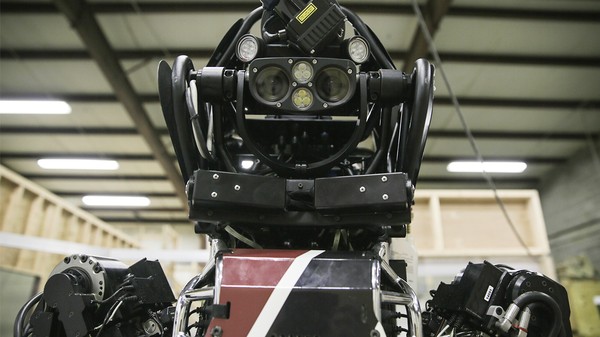Take two six-foot-tall, 330-pound bipedal humanoid robots named ATLAS and ESCHER. They’re not Terminators, but they sure resemble those iconic killer robots from the big screen. When Motherboard gained exclusive access to ATLAS and ESCHER, both of which are funded by the US military, we couldn’t help but ask their human operators if that comparison comes up a lot.
“We do get that a lot,” said David Conner (no relation to John), a senior research scientist with Virginia Tech’s TORC Robotics. With millions of dollars in funding from the Defense Advanced Research Projects Agency, the Pentagon’s blue-sky research lab, TORC services one of seven ATLAS robots, which are built by Google-owned Boston Dynamics. The idea, Conner said, is for ATLAS and similar platforms to help—not kill—humans.
“This is a nice, friendly humanoid rescue robot,” he explained. “It will serve whatever purpose its human operator sends it to.”
Think C-3PO, not T-1000. That’s the more appropriate pop-culture reference, according to Brian Lattimer, another Virginia Tech researcher working on a bipedal humanoid robot with funding from DARPA. His lab’s bot, ESCHER, is designed to “do actions that we don’t want people to be involved with.”
ESCHER is, alongside ATLAS, one of 11 total semi-autonomous ground robots from labs around the world competing in the DARPA robotics challenge, a friendly competition with big cash prizes for performing seemingly simple tasks like having the robot pick up an electric drill or climb stairs.
Conner and Lattimer’s remarks come at a moment when robots and artificial intelligence seem to have both emerged from a decades-long, so-called "winter" of disinterest from across the spectrums of science and technology. Today, the specter of intelligent machines is more palpable than ever. That has a lot of people excited about a not-too-distant era of robot-assisted living, while others are deeply concerned about the dawn of intelligent, killer robots. What will happen when AI software melds with military robotics?
"
If I could sit down with Google people, I would want them to make a public pledge to not become involved with autonomous killer robots"
It’s a question that’s captivating Google. Boston Dynamics is just one of dozens of firms at the forefront of AI and military robotics vacuumed up by the search giant in the past few years. Of course, Google is not strictly a robotics company; about two-thirds of the company's total revenue still comes from YouTube ads and its search engine, The New York Times reported in January. Then again, predictive search is a form of AI.
DARPA, Boston Dynamics, and Google all declined interviews for this story.
Jody Williams would love to sit down with Google cofounders Sergey Brin or Larry Page, if given the chance. Williams won the Nobel Peace Prize in 1997 for her work in banning anti-personnel landmines, and has taken that same fight to stopping killer robots with the appropriately-named Campaign to Stop Killer Robots.
“If I could sit down with Google people, I would want them to make a public pledge to not become involved with autonomous killer robots,” Williams said. “I also want some money from them.”
For their part, Conner, Lattimer, and the dozens of engineering students and professionals working on ATLAS, ESCHER, and the nine other robots participating in the DARPA challenge have the best intentions: they say they’re building tools they hope will help humanity. One can only hope.
Goodbye, Meatbags is a series on Motherboard about the waning relevance of the human physical form. Follow along here, and listen to our podcast, embedded above, for some behind the scenes snippets from the documentary.









